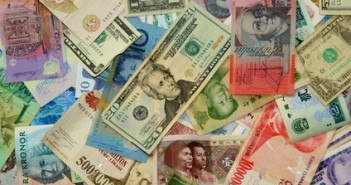Guest post by NewstraderFX
With the Federal Reserve still committed to adding liquidity by purchasing another $800 billion of Treasuries through June, and an economy which is likely to grow between 3% and 4%, we can still look for the dollar to weaken against currencies like the euro, pound and Australian dollar as stocks continue to improve.
However, one cannot simply employ a buy and hold strategy (buying meaning to buy these currencies against the USD); in order to be successful in this market, you will need to use more of a “buy on the dip” approach.
The reason for this is that 4 main risks to the outlook must be taken into account, namely:
- Further problems with European sovereign debt issues
- The potential for state and/or local municipal debt problems
- Rising commodity prices, specifically oil
- The Fed’s QE program
My basic thinking is that while each risk poses problems, none is likely to create the sort of massive crisis such as experienced after the collapse of Lehman Bros. in September 2008. And while each can obviously cause a period of risk aversion which, as we have seen repeatedly, tends to strengthen the greenback as stocks fall, the declines which occur are likely to present investors with excellent buying opportunities.
First and foremost, while the Fed is not directly intervening, there is an important reason (aside from boosting exports) why it is very interested in having the dollar decline; the risk of deflation.
As economist and Harvard professor Martin Feldstein pointed out in a recent paper, “policies that prevent currency appreciation can lead to inflation in countries with excess demand while policies that prevent currency depreciation can lead to deflation in countries with current account deficits.”
Since the U.S. has a large CA deficit, and the Fed is now dedicated to fighting the risk of deflation by creating a higher rate of inflation, what this implies is that markets are very likely to move as they have been since March 2009 when large scale Federal Reserve asset purchases were announced-rising when major risks are absent, selling off when they occur, finding a bottom as the crisis abates, and rising from there.
The latest flare-up over Europe was a perfect example of this phenomenon, when stocks peaked on Nov 5 and then declined (as the dollar gained) while problems in Ireland intensified. After finding support for several days, stocks began a sustained rally on Nov 30. Meanwhile, the euro has gained 392 pips against the dollar, the aussie 693 pips and the pound 103 pips since then.
Europe
Simon Johnson, who is hardly alone in his opinion, believes another serious European crisis can occur in early 2011 due to rollover funding needs of its weaker governments, with debts coming due from March through May.
Harry Wilson, writing in The Telegraph, notes that “banks alone must refinance about €400bn of debt in the first half of the year,” in addition to the “more than €500bn European governments must replace over the same period, as well as further hundreds of billions of euros of mortgage-backed debt maturing.”
Municipals
Banking analyst Meredith Whitney recently predicted that 50-100 American cities will go bust next year, triggering the next leg down in the financial crisis as “hundreds of billions of dollars” in failed municipal debts implode.
One of a number disputing Ms. Whitney’s claim is Fitch analyst Richard Raphael, who has been covering municipal markets for over 30 years. Mr. Raphael noted that “debt service is a relatively small part of most budgets (generally less than 10% and in many cases less), so not paying it does not do much to solve fiscal problems particularly as compared to the costs of such an action.”
Oil
Gasoline prices have moved up sharply in recent weeks, posing a risk to discretionary spending. But there likely is a limit to how far prices can rise before demand becomes affected, probably somewhere around $4 per gallon.
If oil did decline from there energy producers could lead stocks lower, and the dollar would likely gain as a result. But because the overall economy will be improving, we would be very unlikely to see a repeat performance resembling anything like the 2008 sell off. In this scenario, oil is likely to find a bottom somewhere in the $75 to $80 range.
QE
The Fed could begin giving hints regarding what it plans to do with QE2 in the Spring. Indications that the program will not be extended could have the effect of strengthening the dollar and weakening stocks for a time but if the Fed’s reasoning for that turns out to be based on a rosy outlook for growth and employment, markets should rebound after getting over the initial shock.
More serious for investors will be the situation where the Fed decides to extend the program. Because of the fierce political opposition which is sure to come from republicans such as Congressman Ron Paul, the new chairman of the committee which oversees the Federal Reserve, an uncertainty is likely to be created which undoubtedly will have a negative impact on stocks.
If you are interested in free forex trader webinar, contact [email protected] for an invite.
